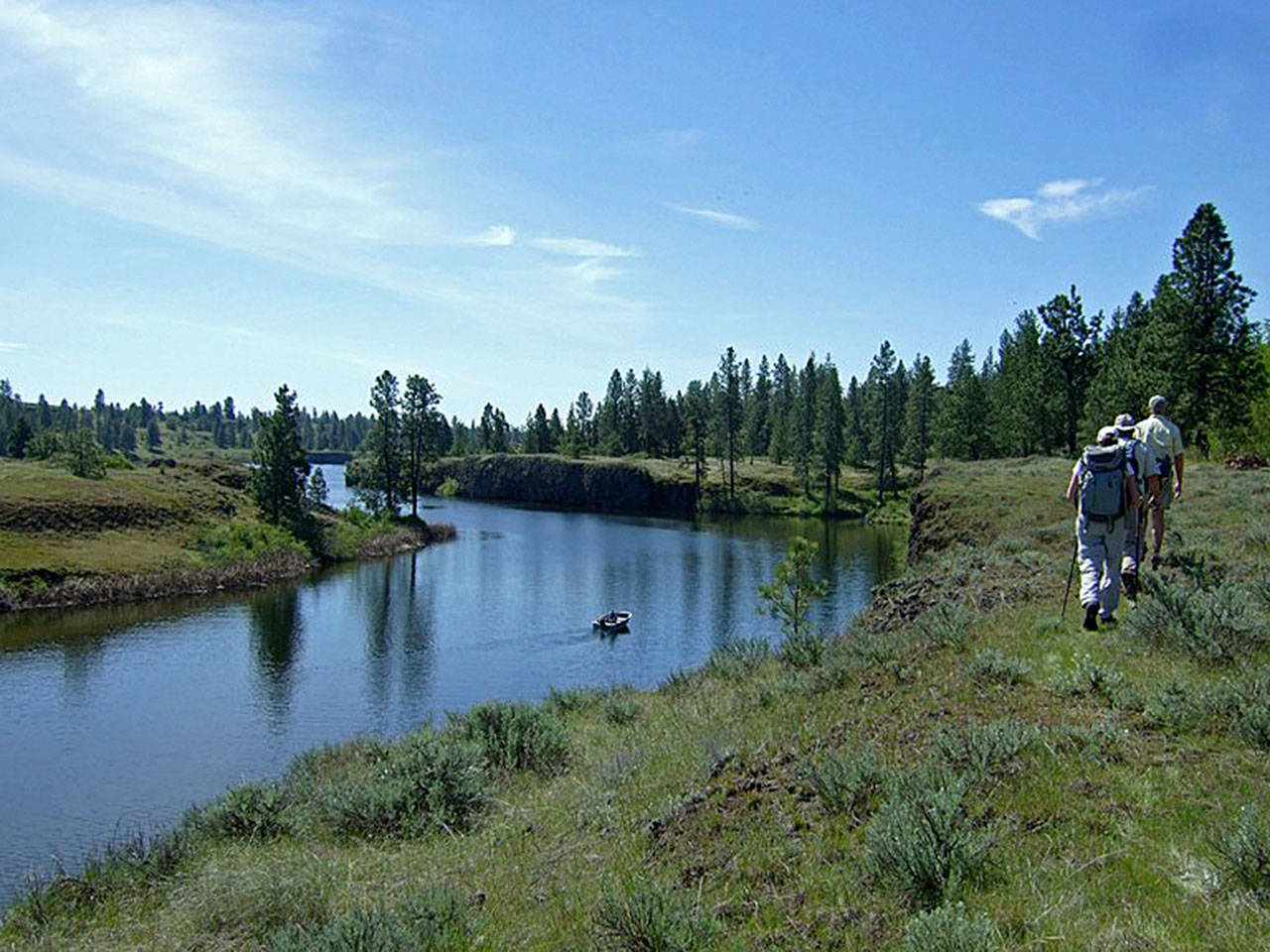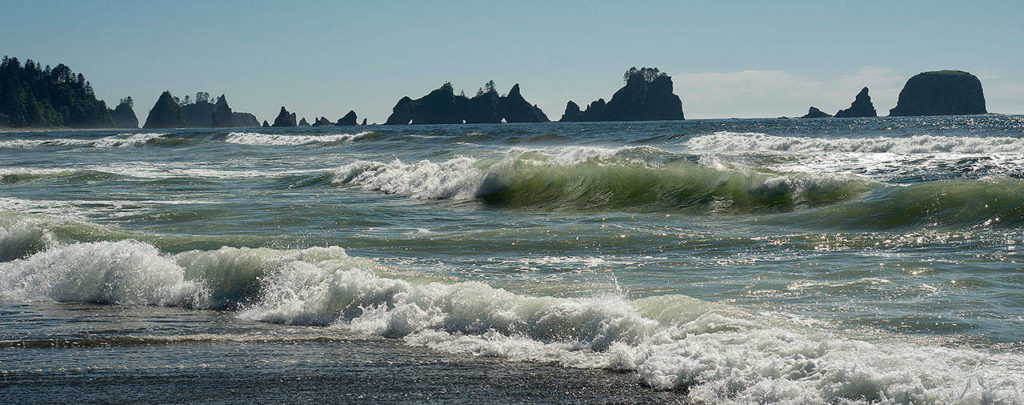By Jonathan Shipley
Washington Trails Association
Poets can bring the beauty of nature to life with their words. On your next hike, bring some poetry with you, and enjoy your time on trail in a new way. To get you started, here are six hikes, paired with six poets to read on those trails.
“Great things are done when men and mountains meet. This is not done by jostling on the street.” — William Blake
In the early 1950s, Gary Snyder left a poem tacked inside a fire lookout in the North Cascades, then strolled back down the trail to civilization.
“I the poet Gary Snyder/stayed six weeks in fifty-three/on the ridge and on this rock/& saw what every lookout sees,/saw these mountains shift about/& end up on the ocean floor/saw the wind and the waters break/The branched deer, the Eagle’s eye/& when pray tell, shall lookouts die?”
The lookouts will not die, for there are hikers, dreamers, poets, lovers, scientists, men, women and children putting on their boots to seek them out. There are people trying to get lost in the wilds — the forests, meadows, rivers, oceans, valleys and prairies — only to find themselves.
In the early 1920s, famed poet Marianne Moore hiked Mount Rainier with her brother. After, she wrote “An Octopus” in response to her trip. “For the hard mountain planned by ice and polished by the wind — /the white volcano with no weather side.”
Elsewhere, in the Pacific Northwest, Joanne Kerran Strangeland wrote: “Fall glistens on the berry vines that twine/and open at the edge of the ravine./Oh, sing before the low, gray rains arrive./She needs the little sting to feel alive.”
Poetry and the natural world live together. From mountain top to valley floor, from prairie fence to ocean shore, hiking, in essence, is a poem of itself. Poets can translate those trails into language and onto paper.
The world of poetry and Washington’s hiking trails is alive. Here are a few hikes and thoughts as to what volume of poetry to take in your backpack as you explore them.
Fourth of July Creek — Joshua Beckman
Joshua Beckman is from Connecticut and lives in Seattle. A wonderful introduction to his poetry is “The Inside of an Apple.”
“Daisies are calming/like horns in some unison of exuberance/I once made out in the warm air/and like a pedal of/the whole world gently serenaded/I stood there./See my feet/in the dirt/with the plants.”
One of the best wildflower hikes in the central Cascades is near Leavenworth. The Fourth of July Creek trail is steep (over 4,300 foot elevation gain) and long (12 miles round trip) but the rewards are many — mountain ranges stretch away while up close the hillsides are bedazzled with balsamroot, lupine and chocolate lilies.
“Knelt down/bowed down/and then over you/and then under you/like a plant/which can’t move/but always shines.”
Beckman’s poetry evokes the simple yet unimaginable beauty of Washington’s wild places. The poems aren’t stories. They don’t have messages to the reader other than to observe. Observe, and perhaps messages will come to you.
Breathe. Take note. Savor.
“Flowers from/the outside/now, full of/living water/like a cloud.” The fragments are less photographic and more light and shadow. “I looked into the darken woods/and though it’s day/I’m thinking now of what light’s left/there in the trees.”
Norway Pass — Emily Johnston
An essayist. No, a memoirist. No, a poet. Emily Johnston’s “Her Animals” is a revelation — discussing our connection, and disconnection, with the earth. It’s a love song and a lament.
“1980: Mt. St. Helens erupts, incinerating hundreds of square/miles — thick cathedrals of age-old forests and sweet damp and/scurrying — and leaving them an ashen devastation. Days later,/geologists in safety vests helicopter in to the crater’s edge. One/hears a whir, then feels a tap-tap-tap at his back: a hummingbird,/already returned, hoping for nectar from the orange of his vest./four grams. Emerald green.”
Norway Pass is a grand introduction to Mount St. Helen’s’ destructive force. The blast zone, on the 4½ mile round-trip hike, is clearly evident. Near treeless and ash blown, the wildflowers and shrubs have taken hold. On the pass, there are vistas of the crater, of Spirit Lake and of the mountain ranges beyond.
“Peering at the stars one night,/I remembered finally that all of this would have ended someday/even without us. In this knowledge, there is rest.”
Shi Shi Beach — Carolyn Kizer
Feminist poet Carolyn Kizer (1925-2014) also was from the Pacific Northwest. She won the Pulitzer Prize in 1985 and helped found Poetry Northwest magazine. Much of her work concerns love, friendships, connection, separation and death. Most of her poems are tinged with the natural world.
“The world’s a tinted shell borne up where waves embrace./its thin convolving valve with close and clasp/this love, so blessed.”
One of the most beautiful hikes along the Washington coast is Shi Shi Beach and Point of Arches on the Olympic Peninsula. The 8-mile round trip hike has it all — sea stacks and Sitka Spruce, tide pools and wheeling shorebirds.
“This is my shallow rocking to Orion:/Curling to touch the seaweed at your side./Wrapping my mermaid hair around your wrists/And seal my face upon your resinous eyes.”
Cheshiahud Lake Union Loop — Claudia Castro Luna
Claudia Castro Luna is Washington’s poet laureate and served as Seattle’s first civic poet from 2015-2017. She was born in El Salvador and has postgraduate degrees in urban planning and poetry.
“Sky favors no one grey upon grey or ocean blue/Lovers and homeless wake up under it wet with dew/The model city we imagine and how to renew.”
As Seattle’s civic poet, she put together the Seattle Poetic Grid, seattlepoeticgrid.com, which traces the city in the voices of its citizens. “We each carry a personal map of the place we inhabit,” according to the site. “We live in the city and the city lives in us.”
The Cheshiahud Lake Union Loop is a 6-mile loop around Seattle’s iconic Lake Union. Named for a Duwamish chief who led a village on the lake, it is a mostly paved urban loop that connects parks and paths. It goes through some of Seattle’s most iconic neighborhoods (like Fremont and Eastlake) and the bustling hive that is South Lake Union. It also goes through Gasworks Park, Lake Union Park and MOHAI. The trail showcases Seattle in its varied wonders.
“Maps of this city/number in the thousands/unique and folded/neatly inside each citizen’s/heart.”
Fishtrap Lake — Richard Hugo
Richard Hugo was a man west of the mountains. A regionalist, who lived in Seattle, his work focused on the economic depression of the Northwest, from the coast to Montana. He grew up in South Seattle (one of his volumes of poetry is titled “White Center”). His writing of small towns, coupled with his love of fishing makes Fishtrap Lake a suitable Hugo hike.
“Where ever we live we sleep here/where cattle sleep beside the full canal./We slept here young in poems.”
Fishtrap Lake is in recovery from the Watermelon Hill fire that broke out in 2014 and took much of the land into smoke. The trail, 4 miles round trip, wanders through the aftermath. Wildflowers and aspen are redolent. The lake, itself, is good for rainbow trout.
“This is the end of wrong hunger. I no longer/troll for big trout or grab for that infantile pride/I knew was firm when my hand ran over/the violet slash on their flanks. My dreams include/wives and stoves.”
Gobbler’s Knob — Lucia Perillo
Lucia Perillo grew up in the suburbs of New York City. She made her way west to San Francisco, where she studied poetry. In the 1980s she became, for a time, a park ranger at Mount Rainier National Park. A resident of Olympia, she died in 2016.
“All day long the sun is busy, going up and going down, and the moon is busy, swinging the lasso of its gravity.”
Beautiful during the sunset, if you can time your hike correctly, Mount Rainier seems like you can touch it when you stand on the fire lookout atop Gobbler’s Knob. The 11-mile round trip hike is unusual in that the first few miles is walking down a now-unused washed out road before you make your way up to pristine Lake George. From George you can look up to your final destination, a lookout peering over sheer cliffs.
Perillo often writes about life in its savage beauty. “There is no alpha, no omega,/no beginning and no end. Only the ceaseless swell/and fall of sunlight on these rusted hills./Watch the way brilliance turns/on darkness. How can any of us be damned.”
Find yourself a poet. Find a slender volume to take up with your trail mix and extra socks. Perhaps not these poets, but perhaps others (Cedar Sigo, Raymond Carver, William Stafford, Frances McCue, JM Miller, Saul Weisberg) will speak to you while Washington’s beautiful wonderland speaks, too.
Washington Trails Association promotes hiking as a way to inspire a people to protect Washington’s natural places. Get inspired to go hiking and learn how you can help protect trails at www.wta.org.
Find the poetry
Joshua Beckman, “The Inside of an Apple,” 2013.
Claudia Castro Luna, “A Corner to Love,” 2015; “Emerald City Blues,” 2016. castroluna.com.
Richard Hugo, “Making Certain it Goes On: The Collected Poems of Richard Hugo,” 1984.
Emily Johnston, “Her Animals,” 2015.
Carolyn Kizer, “The Nearness of You,” 1986.
Lucia Perillo, “Time Will Clean the Carcass Bones: Selected and New Poems,” 2016.
Talk to us
> Give us your news tips.
> Send us a letter to the editor.
> More Herald contact information.


























